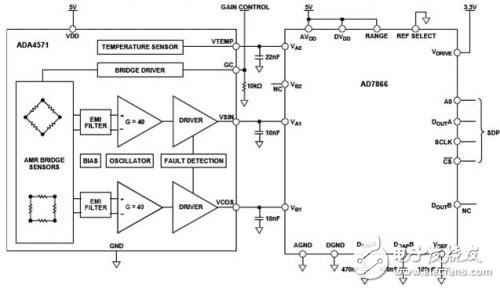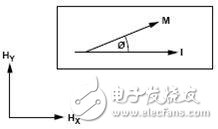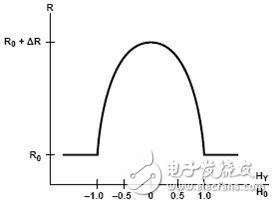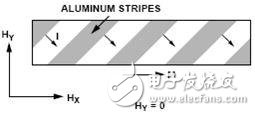Circuit function and advantage
The compact two-chip circuit shown in Figure 1 provides a non-contact anisotropic magnetoresistive (AMR) measurement solution for angular or linear position measurements. The two-chip system has an angular accuracy better than 0.2° over a 180° range and 2 mil (0.002 inch) linear accuracy over a 0.5 inch range, depending on the size of the magnet used.
The circuit is suitable for high speed, high precision, non-contact angle and length measurement critical applications such as machine speed control, crane angle control, brushless DC motors and other industrial or automotive applications.

Figure 1. Magnetoresistive angle and linear detection system (schematic diagram: decoupling and all connections not shown)
Circuit description
The ADA4571 is an anisotropic magnetoresistive (AMR) sensor with integrated signal conditioning amplifier and ADC driver, as well as a temperature sensor for temperature compensation.
The ADA4571 produces two analog outputs that indicate the angular position of the surrounding magnetic field.
The ADA4571 integrates an AMR sensor and a fixed gain (nominal G = 40) instrumentation amplifier. The ADA4571 provides clean and amplified cosine and sinusoidal output signals for rotating magnetic field angles. The T output voltage range is proportional to the supply voltage.
The sensor contains two permeable alloy Wheatstone bridges at an angle of 45°. The rotating magnetic field of the xy sensor plane provides two sinusoidal output signals, and the frequency of the sensor's angle (α) with the direction of the magnetic field is doubled. In the homogeneous field of the xy plane, the output signal is independent of the physical position of the z-direction (air gap).
The output voltage swings at the sine and cosine outputs range from 7% to VDD to 93%. VDD. There are two diagnostic bands (0% to 7% of VDD and 93% to 100% of VDD), which provides soldering to all internal connections. Line disconnection detection.
The ADA4571 is available in an 8-lead SOIC package.
The VSIN and VCOS outputs have an output impedance of 50Ω and a 318 kHz noise filter with an external 10 nF capacitor.
The AD7866 is a dual channel, synchronous sampling, 12-bit, 1 MSPS SAR ADC. The polarity of the RANGE pin determines the analog input range and output coding. If the pin is tied to logic high when the chip select signal goes low, the analog input range for the next conversion is 0 V to 2 & TImes; VREF (0 V to 5 V), 0.35 V to 4.65 for the ADA4571 AMR sensor The V signal provides a margin of approximately 350 mV.
Connect the REFSEL pin to a low level configurable ADC using an internal 2.5 V reference. This voltage is provided by the VREF pin, but the buffer must be used before it can be used elsewhere in the system. The DCAPA pin and the DCAPB pin are decoupled with a 470 nF capacitor to ensure proper operation of the ADC.
The AD7866 simultaneously samples the two channels of the sensor. Digital words are usually provided on the DOUTA and DOUTB sides. Each data stream consists of 1 leading zero followed by 3 status bits plus 12 bits of conversion data. However, keeping the CS pin low for an additional 16 clock cycles, both digital words can be taken from one channel (DOUTA). Therefore, the SPI interface allows access to both channels on one data line.
Both ADC inputs of the AD7866 feature a dual channel multiplexer. A logic 0 on the A0 input pin allows the A1 and A2 inputs to be converted, while a logic 1 on the A0 input pin allows the B1 and B2 inputs to switch. The temperature sensor output of the ADA4571 is connected to the B1 input of the AD7866 and allows software temperature calibration of the system.
Magnetoresistance (MR) Theory Magnetoresistance is the ability of a material to change its resistance when an external magnetic field is present. The most commonly used MR sensors are based on AMR technology.

Figure 2. Example of anisotropic magnetoresistance
An example of the AMR effect is shown in Figure 2. Current (I) flows through the conductor and is affected by an external magnetic field (HY). The change in conductor resistance is a function of the angle between the magnetization vector (M) and the current vector (I). The magnetization vector is the net summation result of the internal magnetic field (HX) and the applied external magnetic field (HY).
When the magnetization vector (M) is parallel to the current vector (I), it has the largest resistance. When the magnetization vector (M) is perpendicular to the current vector (I), it has a minimum resistance.
Effective use of the AMR effect requires that the conductor itself must be insensitive to mechanical stress materials, but sensitive to magnetic constraints. For these reasons, permalloys (80% nickel, 20% iron) are the most commonly used alloys in the manufacture of AMR sensors.
Permeable Alloy Properties Perforated alloy strips have two properties that can be challenging to create an angle measurement system.
First, the permalloy has a narrower linear working area (see Figure 3). The response is linear only when the angle between the magnetization vector (M) and the current vector (I) becomes large. Unfortunately, the magnetically permeable alloy will saturate shortly after the linear response.

Figure 3. Relationship between resistance of magnetically permeable alloy and magnetic field
Second, the permalloy is not sensitive to polarity. Regardless of whether the angle between the magnetization vector (M) and the current vector (I) is positive or negative, the resistance of the permalloy strip will decrease.
Two-color strip magnetic pole A common method for improving the linearity and magnetic pole non-sensitive properties of a permalloy strip is to add an aluminum strip (referred to as a two-color strip magnetic pole, as shown in Figure 4) at 45° to the axial direction of the metal strip. Any current flowing between the two color strip poles will take the shortest path - the vertical path, and the angle between the current vector (I) and the magnetization vector (M) is offset by 45°.

Figure 4. Two-color strip magnetic pole effect of a permalloy strip
Figure 5 shows the results after adding a two-color strip magnetic pole to a permalloy strip. The current vector is offset by 45, but the magnetization vector remains unchanged. Note that the linearity now exists in the central part of the graph.
Sapphire glass. Similar to corundum, it has a hardness of 9. It can produce various colors by adding various chemical elements. The commonly used ones are colorless. It has the advantages of higher hardness and higher price than ordinary glass. It is mainly used to make high-end watch mirrors.
Germanium sapphire glass has good thermal properties, excellent electrical and dielectric properties, and is resistant to chemical corrosion. It has high temperature resistance, good thermal conductivity, high hardness, infrared penetration, and good chemical stability. Therefore, it is often used to replace other optical materials to make optical components, infrared-transmitting optical windows, and is widely used in infrared and far-infrared military equipment, such as: used in night vision infrared and far-infrared sights, night vision cameras and other instruments And satellite and space technology instruments and meters, as well as windows for high-power lasers, various optical prisms, optical windows, UV and IR windows and lenses, observation ports for low-temperature experiments, and high-precision instruments for navigation, aerospace, and aviation. Be fully applied.
For example, infrared transparent window materials, substrate substrates in the field of microelectronics, laser substrates, optical components and other applications.
Sapphire Lens,Sapphire Prism,Crystals Germanium,Germanium Lens Prism Window,BaF2Lens Prism Window
Bohr Optics Co.,Ltd , https://www.bohr-optics.com
